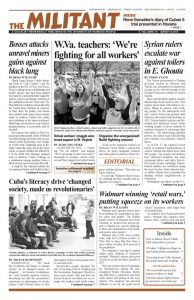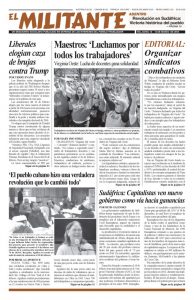NEW YORK — Some 4,000 union members rallied here Feb. 24 — and many more in actions in 27 other cities — two days before a U.S. Supreme Court hearing on whether government workers can opt out of paying union dues.
The protests were billed as a “Working People’s Day of Action” and called for “an end to a system that’s rigged against us.” Publicity mentioned little or nothing about the dues matter.
Illinois state worker Mark Janus, backed by myriad opponents of workers unionization, seeks to overturn a state law that imposes union dues on government workers, who benefit from wages, benefits, seniority protection and other gains won by the union. Janus says, “The union’s fight is not my fight.”
The New York rally program featured Democratic Party politicians, including Gov. Andrew Cuomo and Mayor Bill de Blasio. While “you see labor going backwards all across this country, in New York it’s a different story,” Cuomo claimed. “In New York you see labor going forward.”
Despite the governor’s demagogy, there’s no different story here and rally participants know it. Union membership in New York has been declining like in the rest of the country, while the bosses — with the help of Democratic and Republican politicians alike — impose speedup, push down wages, slash benefits and disregard basic safety measures. And it’s not because of changes around dues checkoff.
That’s why workers milling around the edges of the action I spoke with weren’t much interested in the speeches from the stage. Instead, they spent most of the rally talking to each other, trading stories about conditions on the job and worries about whether or not they’ll have a pension when they retire.
“The politicians always say, I’m with you, I’m with you,” Dabreo Dottin, a union painter, told the Militant. “But they’re never with us.”
The decline in construction union membership has Dottin concerned.
Top union officials like mandatory dues checkoff, because it allows them to keep getting paid — and paid handsomely — while the rank and file faces attacks on jobs, safety, health care and more. They use some of what they collect to tie the fate of the workers to electing so-called friends of labor, mostly Democratic Party politicians.
Union membership at all-time low
Meanwhile, U.S. union membership has sunk to an all-time low. In privately owned factories, mines, transportation and retail it peaked at 35 percent in the 1950s. Today just 6.5 percent of workers at these companies are organized in a union.
In New York City some 90 percent of construction workers were union members in the 1970s. Today it is less than 40 percent.
For decades the union officialdom has failed to organize a fight to take on the bosses’ attacks.
The only power that workers have is the force of our numbers, but this is constantly undermined under capitalism by competition among us for jobs. The bosses take advantage of this to weaken our unions.
No perspective was presented to fight to unite our class and overcome the divisions fostered by the bosses between employed and unemployed; immigrant and native-born; Black, Latino and Caucasian; women and men. Taking on these social questions are key to our ability to use our unions to stand up to the attacks by the bosses and their government today.
Need for a fighting union movement
Most workers alive today have never seen a real fighting union, one run by the rank and file, that fights for the entire working class, that sees the bosses’ political parties as part of the enemy, not our “friend.” But there is a powerful example — the Teamsters union in Minneapolis in the 1930s and its revolutionary leadership.
The story of the organizing drives and strikes that built Teamsters Local 574, turning Minneapolis into a union town, and making the union a tribune for the interests of working people nationally and around the world, is told in a four-volume series by Socialist Workers Party leader Farrell Dobbs: Teamster Rebellion, Teamster Power, Teamster Politics and Teamster Bureaucracy, available from on page 8 or from www.pathfinderpress.com.
Dobbs, a coal yard worker, emerged as a leader of the 1934 Minneapolis Teamsters strikes and of the subsequent 11-state organizing drive.
The bureaucratic view of mandatory dues “sees the closed shop as a liberating instrument — for the bureaucrats, that is, not the workers. It enables officials sitting on top of a union to more or less freely ignore or go against the wishes of the rank and file,” Dobbs wrote in Teamster Power.
“A different view on the same question arises when workers are inspired by the union. They develop a healthy resentment against freeloaders on the job and look for ways of forcing them at least to contribute financially to the cause. This leads them to favor putting a clause in the agreement with the employer making payment of union dues compulsory,” Dobbs says.
When the Minneapolis Teamsters had beaten the bosses “and the local was firmly rooted in the trucking industry, the rank and file strongly favored compulsory union membership and dues payments,” Dobbs says.
The challenge today is for us to build a union movement that inspires working people to stand up and fight.

